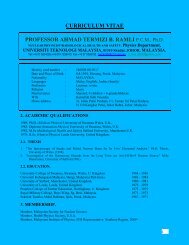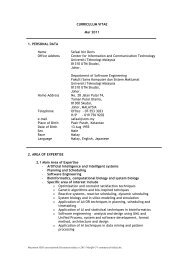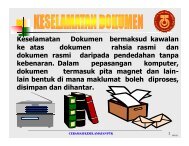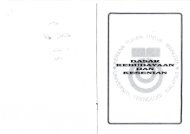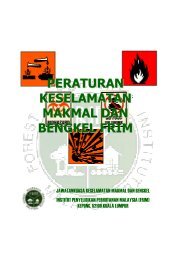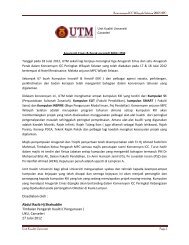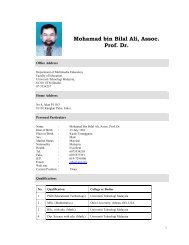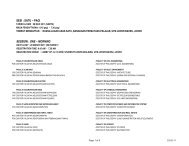Characterization of ASTER Data for Mineral Exploration - UTM
Characterization of ASTER Data for Mineral Exploration - UTM
Characterization of ASTER Data for Mineral Exploration - UTM
Create successful ePaper yourself
Turn your PDF publications into a flip-book with our unique Google optimized e-Paper software.
2.1 <strong>ASTER</strong> Satellite <strong>Data</strong>Two scenes <strong>of</strong> <strong>ASTER</strong> data were used in this study are acquired on July 20, 2007. The imageshave been pre-georeferenced to <strong>UTM</strong> zone 40 North projection with WGS-84 datum. Both datasets are in level 1B <strong>for</strong>mat and are geometric and radiometrically corrected. The crosstalkcorrection was per<strong>for</strong>med to both data sets in this study, aimed at removing the effects <strong>of</strong> energyoverspill from band 4 into bands 5 and 9 (Kanlinowski and Oliver, 2004). We have done thiscorrection by Cross-Talk correction s<strong>of</strong>tware and then VNIR and SWIR data re-sampled so thatall 9 bands have the same 15×15 m pixel size by ERMapper 6.4 System. In addition, the VNIR-SWIR regions <strong>of</strong> Level 1B dataset were also radiometrically calibrated using the InternalAverage Relative Reflection (IARR) method, in order to normalize images to a scene averagespectrum.2.1 <strong>Data</strong> Image AnalysisDigital image processing techniques have been widely used in the search <strong>of</strong> mineral depositsusing multispectral remote sensing images. The basic idea is that the spectral in<strong>for</strong>mation relatedto minerals represents a very small fraction <strong>of</strong> the total in<strong>for</strong>mation content <strong>of</strong> these images.Hence, the useful in<strong>for</strong>mation is <strong>of</strong>ten buried within a vast amount <strong>of</strong> data, mostly unrelated tothe minerals <strong>of</strong> interest, and is usually not identifiable unless the data is properly processed. Thetask is there<strong>for</strong>e per<strong>for</strong>m a systematic selective extraction <strong>of</strong> the in<strong>for</strong>mation <strong>of</strong> interest.There are three widely reported approaches to this task, namely: band ratioing technique; andminimum noise fraction (MNF).2.2.1 Spectral Band RatioingBand ratio techniques are useful in discriminating mineral types and vegetation density in remotesensing image data by suppressing the proportionally constant radiance values in the bands andenhancing the differences (Gupta, 2003; Crosta and Filho, 2003; Rowan and Mars, 2003;Ninomiya, 2003a,b). Ratio images may correlate to one or more surface materials such aslithologic types and vegetation density (Crowley et al., 1989; Sabine, 1997; Gupta, 2003). Theband ratio technique has been widely used to extract hydrothermal mineral in<strong>for</strong>mation in theanalysis <strong>of</strong> Landsat MSS, TM and ETM image data (Perry, 2004). Because <strong>ASTER</strong> has 14spectral channels, more ratio images, and there<strong>for</strong>e more lithologic indices, more accurate resultscan be derived from <strong>ASTER</strong> than from Landsat data. The optimal band selection <strong>for</strong> ratio imagesdepends on the spectral properties <strong>of</strong> the surface material <strong>of</strong> interest and its abundance relative toother surface cover types (Sabine, 1999). The spectral bands <strong>of</strong> the <strong>ASTER</strong> SWIR subsystemwere designed to measure reflected solar radiation in one band centered at 1.65 μm, and fivebands in the 2.10–2.45 μm region in order to distinguish Al-OH, Fe, Mg-OH, H-O-H, and CO3absorption features. Several investigators have documented identification <strong>of</strong> specific minerals,such as calcite, dolomite, and muscovite, as well as mineral groups, through analysis <strong>of</strong> <strong>ASTER</strong>data (Rowan and Mars, 2003; Rowan et al., 2003; Mars and Rowan 2006; Sanjeevi, 2008).Al(OH)-bearing minerals such as kaolinite, muscovite, alunite show absorptions in bands 5 and6, as well as calcite in bands 8 and 9 <strong>of</strong> ASTE data. Ninomiya (2003) looked at spectral features
<strong>of</strong> different minerals in <strong>ASTER</strong> data and <strong>for</strong>mulated this index <strong>for</strong> identification Al(OH)-bearingminerals (OHI) = (Band 7) / [Band6]) × ([Band 4] / [Band 6]). These index was applied to our<strong>ASTER</strong> Level-1B data sets, as well as simple band ratioing <strong>for</strong> specific interested mineral(muscovite=7/6 ) and vegetation(3/2) and iron oxides (gossan=4/2).2.2.2 Principal Components AnalysisThe principal component trans<strong>for</strong>mation is a multivariate statistical technique that selectsuncorrelated linear combinations (eigenvector loadings) <strong>of</strong> variables in such a way that eachsuccessively extracted linear combination, or principal component, has a smaller variance (Singhand Harrison 1985). This is a well-known method <strong>for</strong> lithological and alteration mapping inmetalogenic provinces (Crosta et al, 2003, Crosta and Filho, 2003;Tangestani and Moore 2000,2001,2002; Ranjbar et al. 2004; Gomez et al, 2005; Kargi, 2007; Massironi et al, 2008,Tangestani et al, 2008; Amer et al, 2010). In this study, PCA is per<strong>for</strong>med on <strong>ASTER</strong> data.2.2.3 Minimum Noise FractionMinimum Noise Fraction analysis identifies the locations <strong>of</strong> spectral signature anomalies. Thisprocess is <strong>of</strong> interest to explorationists because spectral anomalies are <strong>of</strong>ten indicative <strong>of</strong>alterations. The minimum noise fraction (MNF) trans<strong>for</strong>m is used to determine the inherentdimensionality <strong>of</strong> image data to segregate noise in the data and to reduce the computationalrequirements <strong>for</strong> subsequent processing (Boardman and Kruse, 1995). This method is similar toprincipal component (PC) analyses that have been used <strong>for</strong> a long time in multispectral imageprocessing, but involves an extra preceding step. The MNF procedure was examined on Resampledata and three sub-system VNIR and SWIR and TIR separately.3. RESULTS AND DISCUSSIONFigures 3 to 4 show the output results <strong>of</strong> spectral band ratioing, PCA and MNF trans<strong>for</strong>msrespectively. Al(OH)-bearing minerals such as muscovite, kaolinite, alunite and iron oxide andvegetation covers can be extracted using spectral band ratioing. These in<strong>for</strong>mation are shownwith highest DN values in <strong>ASTER</strong> satellite data and they are ascoictaed associated withalteration zones around porphyry copper deposits (Fig. 3a). Spectral characteristics <strong>of</strong> vegetationis main obstacle <strong>for</strong> alteration zone identifications. It is observed that Fig.3b shows vegetation’serror as bright pixels that is resulted by band ratioing <strong>of</strong> 3/2. The most important mineral in thealteration zones is muscovite because Phyllic alteration spectral characteristics include muscovitereflectance spectra that exhibits an intense <strong>of</strong> Al-OH absorption feature. This occurred withinwavelength value <strong>of</strong> 2.20 μm (<strong>ASTER</strong> band 6). This result confirmed the study <strong>of</strong> Mars andRowan 2006. Thus, identification <strong>of</strong> muscovite by band ratioing <strong>of</strong> 7/6 can be as good indicator<strong>for</strong> copper mineralization (Fig 3c). This study is similar to Abdelsalam et al., (2000) andTangestani and Moore, (2000). Consequently, Supergene alteration can create extensive ironoxide minerals that is called Gossans. Band ratioing <strong>of</strong> is useful and 4/2 can recognize the ironoxides.(Fig3d). Spectral trans<strong>for</strong>ms involving PCA and MNF, both show similar results andverified band ratioing results especially in, PC4,PC5, PC6 and MNF5, MNF6, MNF7.Fig 4ashows the result as RGB color composite PCA trans<strong>for</strong>mation <strong>for</strong> PC4,PC5, PC6 and fig 4bRGB color composite MNF trans<strong>for</strong>mation <strong>for</strong> MNF5, MNF6, MNF7, respectively.
abcdFig 3. Spectral indicies generated using band ratioing: (a) (OHI) inde , (b) vegetation, (c) muscovite (d) iron oxides(gossan) zoom.4. CONCLUSIONSThis paper has shown that the <strong>ASTER</strong> imagery application in locating and enhancing alterationzones associated with ore deposits such as gold and cooper. Conventional image processingmethods such as band ratioing, (PCA), (MNF) applied on our <strong>ASTER</strong> data. These results areabsolutely correspond with maps provided by Geological Survey <strong>of</strong> Iran and pervious remotesensing investigations that were carried out by Tangestani, and Moore,2001, 2002 on TM dataand Tangestani, et al. 2008 on <strong>ASTER</strong> data in Meiduk region and Ranjbar et al. 2004 on ETM +data in Sarcheshmeh region and Mars and Rowan,2006 on <strong>ASTER</strong> data in the Zagros magmaticarc.
abFig 4. a: RGB color composite PCA trans<strong>for</strong>mation PC567, b: RGB color composite MNF trans<strong>for</strong>mation MNF5,6,7.ReferencesAmer Reda , Timothy Kusky, Abduwasit Ghulam ., 2010. Lithological mapping in the Central Eastern Desert <strong>of</strong>Egypt using <strong>ASTER</strong> data Journal <strong>of</strong> African Earth Sciences 56 , 75–82.Azizi a, Rsaoli aa and Babaei., 2007.Using SWIR from <strong>ASTER</strong> <strong>for</strong> discrimination <strong>of</strong> hydrothermal altered mineralsin the northwest <strong>of</strong> iran(se-sanandajcity);a key <strong>for</strong> exploration <strong>of</strong> copper and goldmineralization. Research journal<strong>of</strong> applied sciences 2(6): 763-768.Bedell, R.L., 2001. Geologicalmapping with <strong>ASTER</strong> satellite: new global satellite data that is a significant leap inremote sensing geologic and alteration mapping. Special Publication, vol. 33. Geo. Soc. <strong>of</strong> Nevada, pp. 329–334.Boardman, J., 1998. Leveraging the high dimensionality <strong>of</strong> AVIRIS data <strong>for</strong> improved sub-pixel target unmixingand rejection <strong>of</strong> false positives: mixture tuned matched filtering. In: Green, R.O. (Ed.), Summaries <strong>of</strong> the SeventhAnnual JPL Airborne Geoscience Workshop, Pasadena, CA, 12–16 January 1998, pp. 55–56.Boardman, J.W., Kruse, F.A., Green, R.O., 1995. Mapping target signatures via partial unmixing <strong>of</strong> AVIRIS data.In: Jakob, V.Z. (Ed.), Summaries <strong>of</strong> the Fifth JPL Airborne Earth Science Workshop, 3. J. P. L, Pasadena, CA, pp.23–26.Clark, R.N., Swayze, G.A., and Gallagher, A.J., 1993a, Mapping minerals with imaging spectroscopy: U.S.Geological Survey Bulletin 2039B, p. 141–150.Crosta, A.P., Souza Filho, C.R., Azevedo, F. and Brodie, C., 2003. Targeting key alteration minerals in epithermaldeposits in Patagonia, Argentina, Using <strong>ASTER</strong> imagery and principal component analysis, International Journal <strong>of</strong>Remote sensing, 24, PP. 4233-4240.Crosta, A.P., Filho, C.R., 2003. Searching <strong>for</strong> gold with <strong>ASTER</strong>. Earth bservation Magazine 12 (5), 38–41.Gad ,S, Kusky ,T,. 2007.<strong>ASTER</strong> spectral ratioing <strong>for</strong> lithological mapping in the Arabian–Nubian shield, theNeoproterozoic Wadi Kid area, Sinai, Egypt. Gondwana Research 11 , 326–335.Gomez Ce´cile, Christophe Delacourt , Pascal Allemand, Patrick Ledru, R. Wackerle ., 2005. Using <strong>ASTER</strong> remotesensing data set <strong>for</strong> geological mapping, in Namibia. Physics and Chemistry <strong>of</strong> the Earth 30, 97–108.Khan Shuhab D, Khalid Mahmood ., 2008. The application <strong>of</strong> remote sensing techniques to the study <strong>of</strong> ophiolites.Earth-Science Reviews 89 , 135–143.Kanlinowski, A. and Oliver, S., 2004. <strong>ASTER</strong> <strong>Mineral</strong> Index Processing. Remote Sensing Application GeoscienceAustralia. Australian Government Geoscience Website: http://www.ga.gov.au/image_cache/GA7833.pdf .Kargi.,2007. Principal components analysis <strong>for</strong> borate mapping. International Journal <strong>of</strong> Remote Sensing Vol. 28,No. 8, 1805–1817.Lowell, J.D., and Guilbert, J.M., 1970, Lateral and vertical alteration-mineralization zoning in porphyry oredeposits: Economic Geology and the Bulletin <strong>of</strong> the Society <strong>of</strong> Economic Geologists, v. 65, no. 4, p. 373–408.
Massironi, M. L. Bertoldi, P. Calafa, D. Visona, A. Bistacchi, C. Giardino, and A. Schiavo,August 1, 2008.Interpretation and processing <strong>of</strong> <strong>ASTER</strong> data <strong>for</strong> geological mapping and granitoids detection in theSaghro massif (eastern Anti-Atlas, Morocco) Geosphere; 4(4): 736 - 759.Mars ,John C and Lawrence C. Rowan . May ,.2006 . Regional mapping <strong>of</strong> phyllic- and argillic-altered rocks in theZagros magmatic arc, Iran, using Advanced Spaceborne Thermal Emission and Reflection Radiometer (<strong>ASTER</strong>)data and logical operator algorithms Geosphere; v. 2; no. 3; p. 161-186.Mezned Nouha , Saˆadi Abdeljaoued, Mohamed Rached Boussema ., 2009. A comparative study <strong>for</strong> unmixingbased Landsat ETM+ and <strong>ASTER</strong> image fusion. International Journal <strong>of</strong> Applied Earth Observation andGeoin<strong>for</strong>mation xxx (2009) xxx–xxx.Ninomiya, Y., 2003a. A stabilized vegetation index and several mineralogic indices defined <strong>for</strong> <strong>ASTER</strong> VNIR andSWIR data. Proc. IEEE 2003 International Geoscience and Remote Sensing Symposium (IGARSS'03) v. 3,Toulouse, France, 21–25 July 2003, pp. 1552–1554.Ranjbara H., M. Honarmandb, Z. Moezifar., 2004. Application <strong>of</strong> the Crosta technique <strong>for</strong> porphyry copperalteration mapping, using ETM+ data in the southern part <strong>of</strong> the Iranian volcanic sedimentary belt. Journal <strong>of</strong> AsianEarth Sciences 24 (2004) 237–243.Resmini, R.G., Kappus, M.E., Aldrich, W.S., Harsanyi, J.C., Anderson, M., 1997. <strong>Mineral</strong> mapping withhyperspectral digital imagery collection experiment (HYDICE) sensor data at Cuprite, Nevada, USA. InternationalJournal <strong>of</strong> Remote Sensing 18 (7), 1553–1570.Rowan, L.C., Mars, J.C., 2003. Lithologic mapping in the Mountain Pass, Cali<strong>for</strong>nia area using AdvancedSpaceborne Thermal Emission and Reflection Radiometer (<strong>ASTER</strong>) data. Remote Sensing <strong>of</strong> Environment 84, 350–366.Rowan Lawrence C, Robert G. Schmidt, John C., 2006, Distribution <strong>of</strong> hydrothermally altered rocks in the RekoDiq, Pakistan mineralized area based on spectral analysis <strong>of</strong> <strong>ASTER</strong> data. Mars Remote Sensing <strong>of</strong> Environment104, p 74–87.Sabins, F.F., 1999. Remote sensing <strong>for</strong> mineral exploration. Ore Geology Reviews 14, 157–183.Singh, A. and Harrison, A., 1985, Standardized principal components. International Journal <strong>of</strong> Remote Sensing, 6,pp. 883–896.Tangestani, M. H. and Moore, F., 2001. Porphyry copper potential mapping using the weights-<strong>of</strong>-evidence model ina GIS, northern Share-e-Babak, Iran, Australian Journal <strong>of</strong> Earth Sciences, 48: 695-701Tangestani, M. H. and F. Moore, (2002) "Porphyry copper alteration mapping at the Meiduk area, Iran",International Journal <strong>of</strong> Remote Sensing, 23 (22), 4815-4825.Tommaso Inés Di, Nora Rubinstein .,2007. Hydrothermal alteration mapping using <strong>ASTER</strong> data in the Infiernilloporphyry deposit, Argentina. Ore Geology Reviews 32 ,p275–290.Yamaguchi, Y., Kahle, A.B., Kawakami, T., Paniel, M., 1998. Overview <strong>of</strong> the advanced spaceborne thermalemission and reflection radiometer (<strong>ASTER</strong>). IEEE Transaction on Geoscience and Remote Sensing 36 (4), 1062–1071.Yamaguchi Y.I, H. Fujisada, M. Kudoh, T. Kawakami ‘, H. Tsu, A.B. Kahle, and M. Pniel .,1999. <strong>ASTER</strong>INSTRUMENT CHARACTERIZATION AND OPERATION SCENARIO. Adv. Space Rex Vol. 23, No. 8, pp.1415-1424.Yamaguchi, Y., Naito, C., 2003. Spectral indices <strong>for</strong> lithologic discrimination and mapping by using the <strong>ASTER</strong>SWIR bands. International Journal <strong>of</strong> Remote Sensing 24 (22), 4311–4323.Zhang Xianfeng, Pazner Micha, Duke Norman., 2007. Lithologic and mineral in<strong>for</strong>mation extraction <strong>for</strong> goldexploration using <strong>ASTER</strong> data in the south Chocolate Mountains (Cali<strong>for</strong>nia). I SPRS Jour nal <strong>of</strong> Photogrammetry &Remote Sensing 62 , 271–282.



